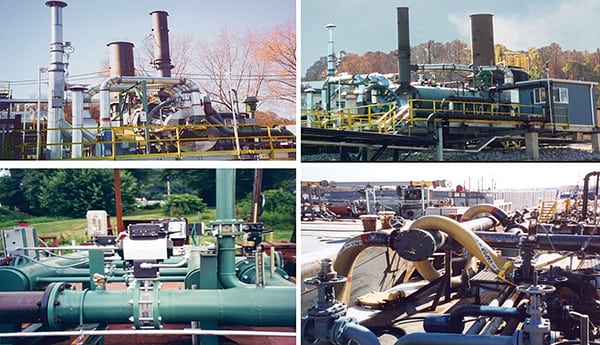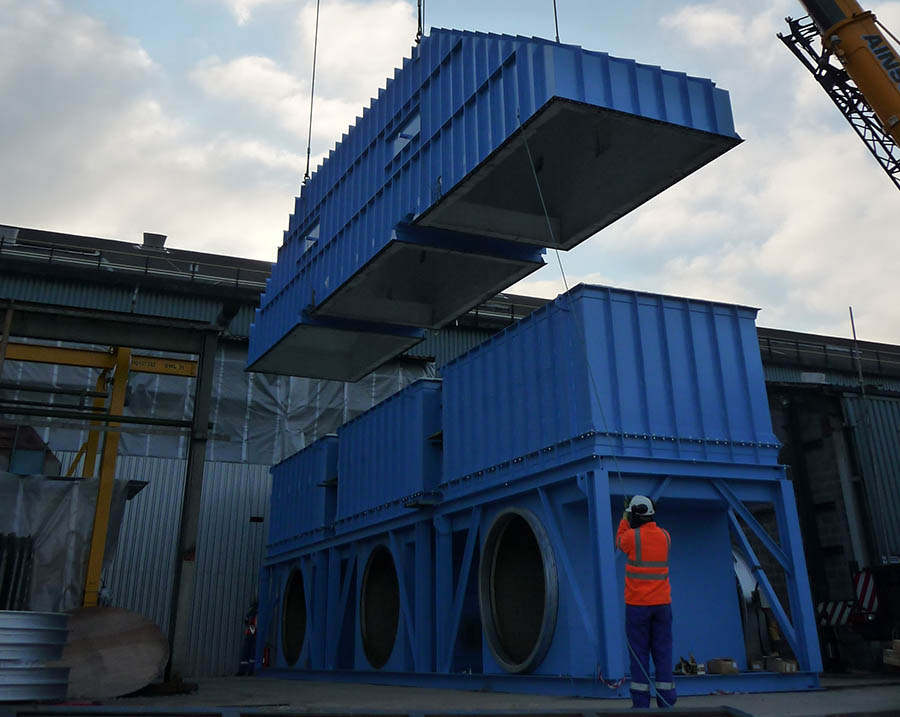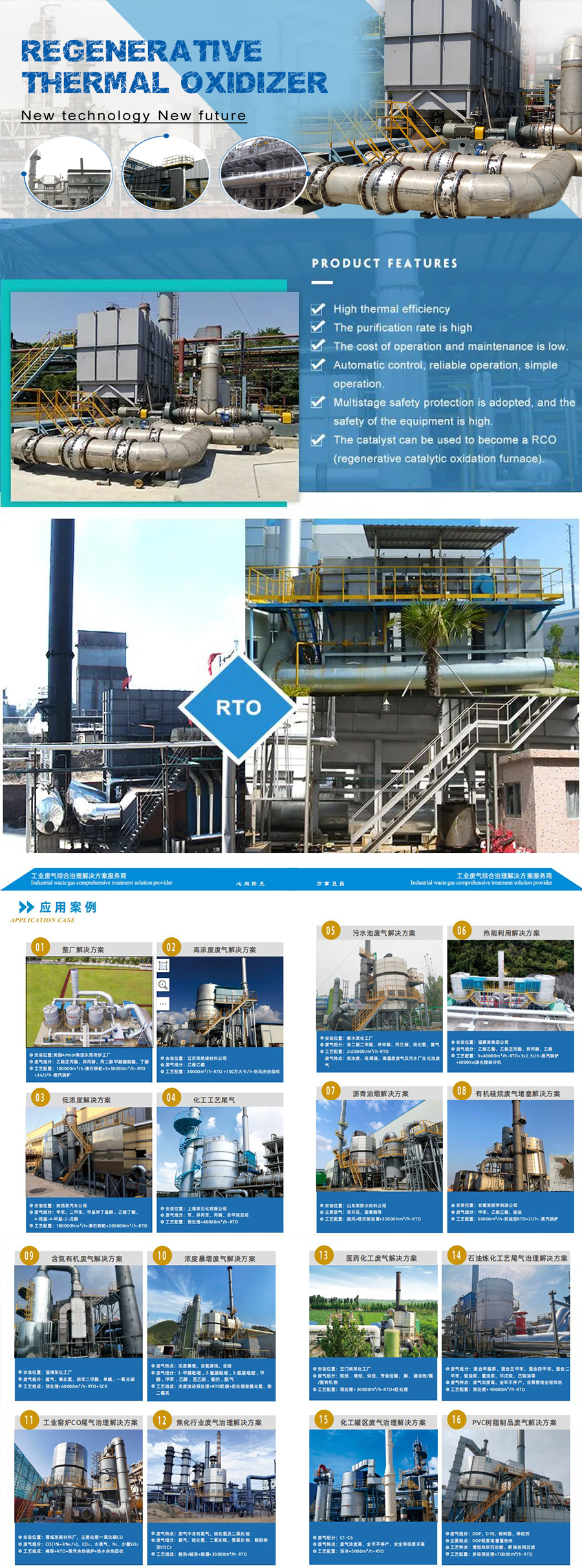معلومات اساسية.
نموذج رقم.
RTO مذهلة
يكتب
محرقة
كفاءة عالية
100
توفير الطاقة
100
صيانة منخفضة
100
سهولة التشغيل
100
العلامة التجارية
بجامازينج
حزمة النقل
في الخارج
مواصفة
111
أصل
الصين
رمز النظام المنسق
2221111
وصف المنتج
رتو
مؤكسد حراري متجدد
بالمقارنة مع الاحتراق الحفزي التقليدي، فإن المؤكسد الحراري المباشر؛ يتميز RTO بكفاءة تسخين عالية، وتكلفة تشغيل منخفضة، والقدرة على معالجة غاز النفايات منخفض التركيز وتدفق كبير؛ عندما يكون تركيز المركبات العضوية المتطايرة مرتفعًا، يمكن تحقيق إعادة تدوير الحرارة الثانوية، مما يقلل بشكل كبير من تكلفة التشغيل؛ لأن RTO يمكنه تسخين غاز النفايات مسبقًا بمستويات من خلال مجمع الحرارة الخزفي، مما قد يجعل غاز النفايات ساخنًا تمامًا ومتشققًا بدون زاوية ميتة (كفاءة المعالجة> 99٪)؛ مما يقلل من أكاسيد النيتروجين في غاز العادم؛ إذا كانت كثافة المركبات العضوية المتطايرة> 1500 مجم / متر مكعب؛ عندما يصل غاز النفايات إلى منطقة التكسير، يتم تسخينه إلى درجة حرارة التكسير بواسطة مجمع الحرارة، سيتم إغلاق الموقد في هذه الحالة.
يمكن تقسيم RTO إلى نوع الغرفة والنوع الدوار وفقًا لاختلاف وضع التشغيل. يتمتع النوع الدوار RTO بمزايا في ضغط النظام، واستقرار درجة الحرارة، ومقدار الاستثمار، وما إلى ذلك.
| أنواع RTO | كفاءة | تغير الضغط (مليمتر مكعب)؛ | مقاس | (الحد الأقصى)؛حجم العلاج | |
| كفاءة العلاج | كفاءة إعادة تدوير الحرارة | ||||
| نوع دوار RTO | 99% | 97% | 0-4 | صغير (مرة واحدة)؛ | 50000 نيوتن متر مكعب/ساعة |
| نوع RTO ذو ثلاث غرف | 99% | 97% | 0-10 | كبير (1.؛5 مرات)؛ | 100000 نيوتن متر مكعب/ساعة |
| نوع RTO ذو غرفتين | 95% | 95% | 0-20 | وسط (1.؛2 مرات)؛ | 100000 نيوتن متر مكعب/ساعة |
مؤكسد حراري متجدد، مؤكسد حراري متجدد، مؤكسد حراري متجدد، مؤكسد حراري، مؤكسد حراري، مؤكسد حراري، مؤكسد، مؤكسد، مؤكسد، محرقة، محرقة، معالجة الغازات العادمة، معالجة الغازات العادمة، معالجة الغازات العادمة، معالجة المركبات العضوية المتطايرة، معالجة المركبات العضوية المتطايرة، معالجة RTO، RTO، RTO، RTO، دوار RTO، دوار RTO، دوار RTO، غرفة RTO، غرفة RTO، غرفة RTO
العنوان: الطابق الثامن، E1، مبنى Pinwei، طريق Dishengxi، Yizhuang، ZheJiang، الصين
نوع العمل: مصنع/شركة تصنيع، شركة تجارية
نطاق العمل: الكهرباء والإلكترونيات، المعدات والمكونات الصناعية، آلات التصنيع والمعالجة، المعادن والطاقة
شهادة نظام الإدارة: ISO 9001، ISO 14001
المنتجات الرئيسية: Rto، خط طلاء الألوان، خط الجلفنة، سكين الهواء، قطع غيار لخط المعالجة، الطلاء، المعدات المستقلة، بكرة الحوض، مشروع التجديد، المنفاخ
مقدمة عن الشركة: شركة ZheJiang Amazing Science & Technology Co., Ltd هي شركة مزدهرة عالية التقنية، تقع في منطقة التنمية الاقتصادية والتكنولوجية في ZheJiang (BDA). تلتزم شركتنا بمفهوم الواقعية والإبداع والتركيز والكفاءة، وتخدم بشكل أساسي صناعة معالجة غازات النفايات (VOCs) والمعدات المعدنية في الصين وحتى العالم أجمع. لدينا تكنولوجيا متقدمة وخبرة غنية في مشروع معالجة غازات النفايات VOCs، والذي تم تطبيق مرجعه بنجاح في صناعة الطلاء والمطاط والإلكترونيات والطباعة وما إلى ذلك. لدينا أيضًا سنوات من تراكم التكنولوجيا في البحث وتصنيع خط معالجة الفولاذ المسطح، ونمتلك ما يقرب من 100 مثال للتطبيق.
تركز شركتنا على البحث والتصميم والتصنيع والتركيب والتشغيل لنظام معالجة غاز النفايات العضوية المتطايرة ومشروع تجديد وتحديث خط معالجة الفولاذ المسطح لتوفير الطاقة وحماية البيئة. يمكننا تزويد العملاء بالحلول الكاملة لحماية البيئة وتوفير الطاقة وتحسين جودة المنتج وغيرها من الجوانب.
نحن نشارك أيضًا في قطع الغيار المختلفة والمعدات المستقلة لخط طلاء الألوان، خط الجلفنة، خط التخليل، مثل الأسطوانة، المقرن، المبادل الحراري، جهاز الاسترداد، سكين الهواء، المنفاخ، اللحام، مستوي التوتر، ممر الجلد، مفصل التمدد، القص، الموصل، الخياطة، الموقد، الأنبوب المشع، محرك التروس، المخفض، إلخ.

How much energy can be recovered by a regenerative thermal oxidizer?
The amount of energy that can be recovered by a regenerative thermal oxidizer (RTO) depends on several factors, including the design of the RTO system, the operating conditions, and the specific characteristics of the exhaust gases being treated. Generally, RTOs are known for their high energy recovery efficiency, and they can recover a significant portion of the thermal energy from the exhaust gases.
Here are some key factors that influence the energy recovery potential of an RTO:
- Heat Recovery System: The design and efficiency of the heat recovery system in the RTO significantly impact the amount of energy that can be recovered. RTOs typically use ceramic media beds or heat exchangers to capture and transfer heat between the exhaust gases and the incoming untreated gases. Well-designed heat exchangers with a large surface area and good thermal conductivity can enhance the energy recovery efficiency.
- Temperature Differential: The temperature difference between the exhaust gases and the incoming untreated gases affects the energy recovery potential. The greater the temperature differential, the higher the potential for energy recovery. RTOs operating at higher temperature differentials can recover more energy compared to those with smaller differentials.
- Flow Rates and Heat Capacity: The flow rates of the exhaust gases and incoming untreated gases, as well as their respective heat capacities, are important factors in determining the energy recovery capability. Higher flow rates and larger heat capacities result in more heat available for recovery.
- Process Specifics: The specific characteristics of the industrial process and the composition of the exhaust gases being treated can influence the energy recovery potential. For example, exhaust gases with high concentrations of volatile organic compounds (VOCs) or other combustible components can provide a higher energy recovery potential.
- Efficiency and System Optimization: The efficiency of the RTO system itself, including the combustion chamber, heat exchangers, and control mechanisms, also plays a role in the energy recovery. Well-maintained and optimized RTO systems can maximize the energy recovery potential.
While it is challenging to provide an exact numerical value for the energy recovery potential of an RTO, it is not uncommon for RTOs to achieve energy recovery efficiencies in the range of 90% or higher. This means that they can recover and reuse 90% or more of the thermal energy contained in the exhaust gases, significantly reducing the need for external fuel sources.
It’s important to note that the actual energy recovery achieved by an RTO will depend on the specific operating conditions, pollutant concentrations, and other factors mentioned above. Consulting with RTO manufacturers or conducting a detailed energy analysis can provide more accurate estimations of the energy recovery potential for a particular RTO system.

What is the role of insulation in a regenerative thermal oxidizer?
In a regenerative thermal oxidizer (RTO), insulation plays a crucial role in improving energy efficiency, maintaining process temperatures, and ensuring the safe operation of the system. The primary role of insulation in an RTO is as follows:
- Thermal Efficiency: Insulation helps reduce heat loss from the RTO, improving its thermal efficiency. By minimizing heat loss, insulation ensures that a significant portion of the energy generated during the combustion process is effectively utilized for heating the incoming process air or gas stream. This results in lower fuel consumption and reduced operating costs.
- Temperature Maintenance: Insulation helps maintain the desired operating temperatures within the RTO. By preventing excessive heat loss, insulation ensures that the combustion chamber, heat exchangers, and other components remain at the required temperatures for effective pollutant destruction. Consistent and stable operating temperatures are critical for achieving high destruction efficiencies and complying with regulatory emissions standards.
- Personnel Protection: Insulation provides a protective barrier that helps prevent the external surfaces of the RTO from becoming excessively hot. This protects personnel working in the vicinity of the RTO from accidental contact with hot surfaces, reducing the risk of burns or injuries.
- Equipment Protection: Insulation also serves to protect the structural components of the RTO from excessive heat. By reducing the heat transfer to the outer surfaces, insulation helps prevent thermal stress and potential damage to the equipment. This extends the lifespan of the RTO and reduces the need for frequent repairs or replacements.
- Condensation Prevention: Insulation can also help prevent condensation within the RTO system. By maintaining the temperature above the dew point of the gases, insulation minimizes the risk of moisture condensing on the surfaces, which could lead to corrosion or other operational issues.
The type and thickness of insulation used in an RTO may vary depending on factors such as the operating temperatures, the specific design of the system, and regulatory requirements. Common insulation materials used in RTOs include ceramic fiber, mineral wool, and other high-temperature insulation products.
Overall, insulation is a critical component of an RTO as it contributes to energy efficiency, process temperature control, personnel safety, equipment protection, and prevention of condensation-related issues.

What are the key components of a regenerative thermal oxidizer?
A regenerative thermal oxidizer (RTO) typically consists of several key components that work together to achieve effective air pollution control. The main components of an RTO include:
- 1. Combustion Chamber: The combustion chamber is where the oxidation of the pollutants takes place. It is designed to withstand high temperatures and house the ceramic media beds that facilitate heat exchange and VOC destruction. The combustion chamber provides a controlled environment for the combustion process to occur efficiently.
- 2. Ceramic Media Beds: Ceramic media beds are the heart of an RTO. They are filled with structured ceramic materials that act as a heat sink. The media beds alternate between the inlet and outlet sides of the RTO, allowing for efficient heat transfer. As the VOC-laden air passes through the media beds, it is heated by the stored heat from the previous cycle, promoting combustion and VOC destruction.
- 3. Valves or Dampers: Valves or dampers are used to direct the airflow within the RTO. They control the flow of the process air and the direction of the exhaust gases during the different phases of operation, such as the heating, combustion, and cooling cycles. Proper valve sequencing ensures optimal heat recovery and VOC destruction efficiency.
- 4. Burner System: The burner system provides the necessary heat to raise the temperature of the incoming process air to the required combustion temperature. It typically uses natural gas or another fuel source to generate the heat energy needed for the destruction of VOCs. The burner system is designed to provide stable and controlled combustion conditions within the RTO.
- 5. Heat Recovery System: The heat recovery system enables energy efficiency in an RTO. It captures and preheats the incoming process air by utilizing the heat energy from the outgoing exhaust stream. The heat exchange occurs between the ceramic media beds, allowing for significant energy savings and reducing the overall operating costs of the RTO.
- 6. Control System: The control system of an RTO monitors and regulates the operation of various components. It ensures proper valve sequencing, temperature control, and safety interlocks. The control system optimizes the performance of the RTO, maintains the desired destruction efficiency, and provides necessary alarms and diagnostics for efficient operation and maintenance.
- 7. Stack or Exhaust System: The stack or exhaust system is responsible for releasing the treated and cleaned gases into the atmosphere. It may include a stack, ductwork, and any necessary emission monitoring equipment to ensure compliance with environmental regulations.
These key components work together in a coordinated manner to provide efficient air pollution control in a regenerative thermal oxidizer. Each component plays a critical role in achieving high VOC destruction efficiency, energy recovery, and compliance with environmental standards.

editor by Dream 2024-11-26
